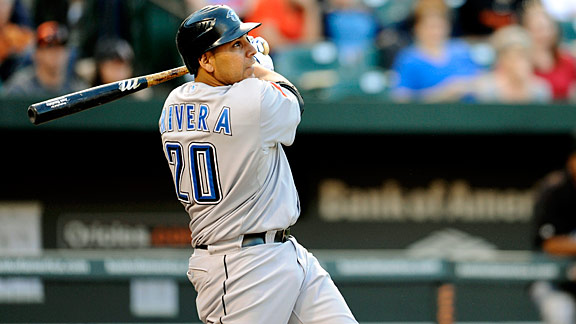Alex Castellanos
“… A 25-year-old right-handed hitter, he has mediocre tools but has put up big numbers this year. His plate discipline needs work, and despite the line at Springfield I’d rate him a Grade C prospect at this point, with a chance to be a bench asset.”
– John Sickels, Minor League Ball
Tim Federowicz
“… Federowicz is a catch-and-throw specialist who isn’t likely to produce enough at the plate to be an average regular, but is plus across the board behind the plate (including a career 34 percent caught-stealing rate) and is no worse than a good backup in the majors.”
– Keith Law, ESPN.com
“… The best defensive catcher in the Red Sox system, with the catch-and-throw skills to be a big league regular. His pure arm strength is average, but it plays up because he has smooth footwork and a quick release. He has thrown out 36 percent of basestealers this year in Double-A, and also has shown off his receiving ability by committing just one passed ball. Federowicz’s bat will determine how much he plays when he gets to the majors. He ability to hit for average and control the strike zone is decent, and he has some gap power. He runs well for a catcher and has more athleticism than most backstops.”
– Baseball America
“… A top-flight defensive catcher, he has a strong throwing arm, plenty of mobility, and excellent leadership skills behind the plate. A weak stick has kept him off prospect lists. … He probably won’t hit enough to be a major league regular, but he could last a long time as a defense-oriented reserve. He turns 24 this week. Grade C.”
– John Sickels, Minor League Ball
“… He’s a very good catch-and-throw guy, with a quick release and strong arm. He’s also worked very hard to improve his blocking. At the plate, he uses a middle-of-the-field approach and has average pull power. Most see him as a defensive-oriented backup at the big league level, but he could become an everyday guy if he hits a bit more than expected.”
– Jonathan Mayo, MLB.com
Stephen Fife
“… Fife probably profiles as a right-handed reliever rather than a starter because he lacks the out pitch to start; he’ll touch 95 as a starter with a fringe-average curveball.”
– Law
“… Didn’t start pitching regularly until he was a high school senior, but after three years of college ball at Utah he worked himself into the third round of the 2008 draft. His best pitch is an 88-93 mph fastball that features good sink. He lacks an above-average secondary pitch, with his changeup (which has some splitter action) ranking ahead of his curveball. His control and command are average, and it’s more likely that he develops into a middle reliever than a starter.”
– Baseball America
“… His stuff is average across the board: 88-92 MPH sinking fastball, average changeup and curveball, but he throws strikes and keeps the ball low in the zone. … In the majors, he projects as a fifth starter or more probably a long/middle reliever. I’ve see him as a sleeper in the past but he’s never quite woken up. Grade C.
– Sickels
“… Fife is a solid right-handed starter with a three-pitch mix. An Eastern League All-Star this season, Fife can run his fastball up to 93 mph with some sink. His curveball can be an out pitch, and he’s also got a pretty good feel for a changeup. He mixes his pitches well and can change speeds, but he also has enough velocity to put hitters away at times.”
– Mayo
Juan Rodriguez
“… Rodriguez has a plus fastball, no average second pitch and below-average command and control – a nice arm to add to your system but a reliever at best and not a high-probability guy, either. Unless Robinson was somehow burning a hole in the Dodgers’ pockets, this (trade) doesn’t make a ton of sense to me, as they didn’t get any prospect as good as he is in the exchange.”
– Law
“… He still has room for projection in his 6-foot-5, 195-pound frame, and he already throws 93-95 mph coming out of the bullpen, enabling him to rank second among South Atlantic League relievers with 13.42 strikeouts per nine innings. There’s a good deal of effort in Rodriguez’s delivery, which hampers his control and command. His slider and changeup are fringy pitches, so his ceiling is as a late-inning reliever rather than as a starter.”
– Baseball America
“… His command is spotty and his slider is mediocre, but his 92-95 MPH fastball has movement and his K/IP ratio is excellent. He needs to sharpen up his command and add polish, but he’s an interesting arm at least. Grade C, but has some upside.”
– Sickels
“… Rodriguez is a raw, tall and lanky right-hander with plenty of arm strength. Pitching out of the bullpen for Greenville in the South Atlantic League, he’s shown plus velocity, up to 98-99 mph at times. He’s got a slider that’s below average, and he’s working to develop a better feel for an offspeed pitch. He generally throws strikes, but he needs to find more consistency with his fastball command. That, and development of his offspeed stuff, will be key. But the power and arm strength that many teams covet are definitely there.”
– Mayo





